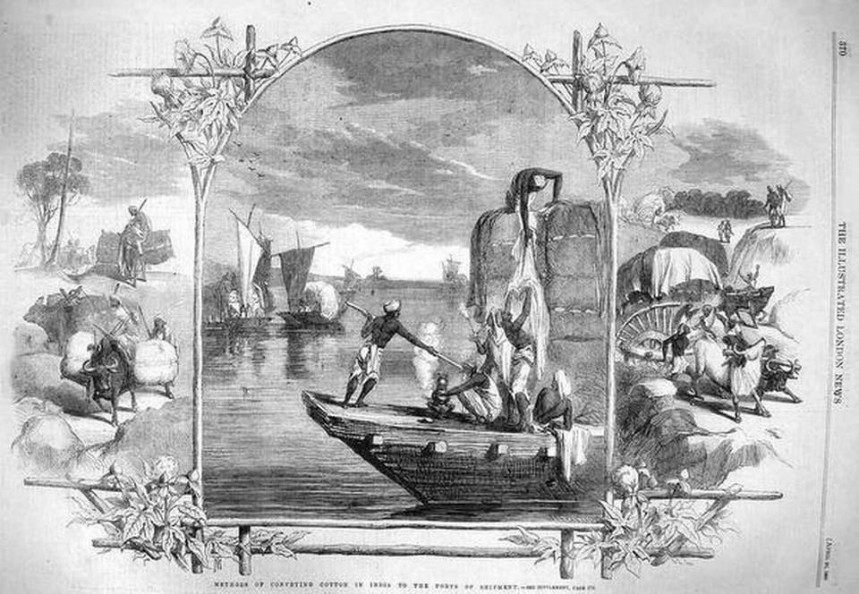Two hundred years ago the first cotton mill was set up in India
Daniel Defoe once lamented in his weekly, The Review,
That was in 1708. The old English East India Company had just merged with the United Company of Merchants of England to become the East India Company. That same year, the company’s Indian headquarters shifted from Bombay to Calcutta. A century later, in 1818, the first Indian cotton mill, the Bowreah Mills, was created by Henry Gouger (or Patrick, in some accounts) at Fort Gloster in the Hughli district of Calcutta.
Fuelling slavery
Indian cotton was the gasoline for the Industrial Revolution in Britain as well as the accelerator of railway projects in India. Shashi Tharoor has famously remarked that India “paid for its own oppression” under British rule. India has exported cotton and fabrics to Europe since the 16th century — in the process procuring its own slavery and that of Africa.
Harvard historian Sven Beckert writes in Empire of Cotton
The first truly Indian cotton mill is usually attributed to Cowasjee Nanabhai Davar of Bombay Spinning and Weaving Company. Built in Bombay in 1851, it started work in 1854. The very first cotton mills in India, however, were powered by the British. Bowreah Mills was built for £200,000, for 20,000 spindles and 100 looms, and was a pioneering attempt at imperial technology transfer to India.
The mill employed European women to teach machine-spinning skills to local workers. In the 1840s, the Mills was in a large complex that “included a cotton twist yarn factory, a rum distillery, a foundry, an oil mill, and a paper mill. There were five steam engines in the complex.” In the 1870s, it had grown to 45,000 spindles. By then, India had 47 mills in operation.
Looking east
When the American Civil War broke out (1861-65), the export of long-staple American cotton to the Lancashire Mills stopped, becoming the chief reason why Britain began to look towards India for raw cotton. Britain thus bought India’s crop, grown under strict regulations of imperial revenue and taxation, finished it into cheap textiles using British technology, and oversold it to the colony under the monopoly of its administration.
‘Press for packing Indian cotton,’ Illustrated London News, 1864. | Photo Credit: Wiki Commons
The number of cotton mills in India rose from 58 in 1880 to 79 in 1883, 193 in 1900, 271 in 1914, and 334 in 1929 — mostly in Bombay and Ahmedabad. Before the outbreak of World War II, they employed 4,00,000 Indians. And this came about a little over a century after driving millions of homespun cotton weavers and craftsmen to mortal bankruptcy.
Before this revolution, Dhaka muslin was the lavish article in Britain, but soon the delicacy of Indian cotton was being feted. French travellers Francois Bernier and Jean-Baptiste Tavernier wrote of its ubiquity in Mughal harems and on the bodies of royal personages. Meena Menon and Uzramma write in A Frayed History: The Journey of Cotton in India that Indian muslins were known as aab-e-rawan (running water), shabnam (evening dew) and beft hawa (woven air).
Even after the Battle of Plassey, when East India Company took control of over 70% of the world’s saltpetre by controlling Bengal, cotton continued to be its principal export to Europe — occupying 75% of the company’s total trade in 1766.
After acquiring monopoly over all trade in Bengal and Gujarat, Britain militarised and bureaucratised its naval and industrial expansion by the late 18th century. The India cotton trade became a three-continent spanning enterprise: “cotton from India, slaves from Africa, and sugar from the Caribbean moved across the planet in a complex commercial dance,” writes Beckert.
Lancashire and Manchester — the cotton textile manufacturing and retailing cities of Britain — profited tremendously from the market for Indian cotton that had already existed in pre-industrial Europe.
Mining the ‘white gold,’ as cotton was also called, became Britain’s native industry. The mourning spectres of weavers in Bengal, Mysore and Gujarat haunted the Raj, in what the philosopher Jacques Derrida calls, in Specters of Marx (1994), the séance of a commodity “as a ghostly silhouette”.
Deep paradox
Gandhi understood the ghostliness of an industry that had mummified weavers into power looms. And one of the first strikes he led was at a cotton mill in Ahmedabad in 1918.
The charkha was Gandhi’s attempt to crystallise the very deep paradox of an Indian economy and culture in the hands of Western imperialism. The real colonisation was not just British economic exploitation, but the transition of India from a self-sustained economy to an industrialised nation, which would preserve and perpetuate the class divide.
It is crucial to remember Bowreah Mills in the context of India’s cotton history, and Gandhi’s radical experiment to decolonise and emancipate the agrarian economy. In just about 100 years — from 1708 to 1818 — the East India Company came around from imitating Indian textiles to inundating India scene with British textiles.
In another 100 years, that is, by the 1930s, the Mahatma, passionate about exorcising the ghosts of previous centuries, wanted to boycott not only British-manufactured cotton, but also cotton produced in Indian mills. Even though two of his most notable companions, Ghanshyam Das Birla, a cotton magnate, and Jawaharlal Nehru, opposed this theatrical idea of swaraj.
Five years ago, in 2013, there were about 2,000 cotton mills in India. This was still 600 less than the number of mills in Lancashire alone in 1860. Two hundred years after its first cotton mill, India has been unable to come close to the scale that Britain enjoyed during the Industrial Revolution. And from 2013 to 2017, although still the third biggest cotton exporter in the world, India’s total cotton exports have fallen by a staggering 59%. The chatterati might focus on the Modi jacket, but the real story of cotton lies far beyond these superficial concerns.
The writer is author of The Purveyors of Destiny: A Cultural Biography of the Indian Railways.


